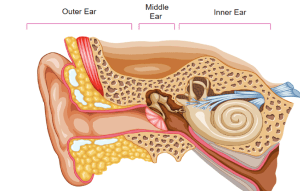Your ear is made up of three parts— the outer, the middle, and the inner ear. The outer ear consists of the parts that we can see from the outside – the outside of the ear and the ear canal. The middle ear consists of the ear drum, the middle ear cavity and Eustachian tube, and three tiny bones called the malleus, incus, and stapes (you may have heard of them by the names the hammer, anvil, and stirrup). Within the inner ear lies the cochlea, which is your organ of hearing, and our inner-ear balance system, called the vestibular system. Depending on which of these three areas has a problem determines which type of hearing loss you have.

Sensorineural Hearing Loss
Sensorineural hearing loss (SNHL) happens after damage occurs to the inner ear hearing system. Within the inner ear lies the cochlea, and within the cochlea are tiny hair cells called stereocilia. These hair cells are the start of the auditory, or hearing, nerve. SNHL occurs when damage occurs to these hair cells or to the nerve pathways from your cochlea to your brain. SNHL is the most common type of hearing loss and is typically permanent. Most of the time, medicine or surgery cannot fix SNHL, but hearing aids may help you hear.
What Causes SNHL?
The most common causes of SNHL are age-related hearing loss (presbycusis), loud noise exposure, and hearing loss that runs in the family. But did you know other things can cause hearing loss as well? See below for other causes of SNHL.
- Illnesses
- Drugs that are toxic to hearing
- A blow to the head
- A problem in the way the inner ear is formed
What might SNHL sound like?
The symptoms of SNHL may be different depending on the cause of the loss, the severity of the loss, and how long one has had the loss. Some common complaints one might have with SNHL are:
- Difficulty hearing voices in places with background noise, for example at parties, restaurants, or family gatherings
- Difficulty hearing or understanding female or children’s voices
- Difficulty understanding speech on the TV or phone and needing to turn up the volume
- Problems hearing soft or high-pitched sounds such as the clock ticking, the refrigerator humming, or the birds singing
- While soft sounds may be hard to hear, louder sounds may be unclear, muffled, or even uncomfortable.
- Many people also report tinnitus (ringing, buzzing, humming noises)
Conductive Hearing Loss
Conductive hearing loss (CHL) happens when sounds cannot get through the outer and middle ear. It may be hard to hear soft sounds, and louder sounds may be muffled. Medicine or surgery can often (but not always) fix this type of hearing loss.

What causes CHL?
There are many possible causes of a CHL. Here are the most common causes:
- Ear infections (otitis media)
- Eustachian tube dysfunction. The Eustachian tube helps drain fluid and equalize pressure in your middle ear space. Fluid can stay in the middle ear if the tube does not work correctly.
- A hole in your eardrum.
- Earwax built up in your ear canal.
- Infection in the ear canal, called otitis externa. You may hear this called swimmer’s ear.
- A foreign object stuck in your ear canal.
- A problem with how the outer or middle ear is formed. Some people are born without an outer ear. Some may have a deformed ear canal or have a problem with the bones in their middle ear, called otosclerosis.
What might CHL sound and feel like?
The symptoms of CHL may change depending on the cause of the loss. Here are the common symptoms one may have with a CHL.
- Muffled hearing
- Sudden or steady loss of hearing
- Full or “stuffy” sensation in the ear
- Draining of the ear
- Pain or tenderness in the ear
- Dizziness associated with head, sinus, and ear pressure
- Tinnitus, or ringing in the ears
Mixed Hearing Loss
Mixed hearing loss (MHL) is a combination of both conductive and sensorineural hearing loss.
This means that there may be an obstruction in the outer or middle ear and also damage in the inner ear or nerve pathway to the brain. This is a mixed hearing loss.
What causes MHL?
Anything that causes a CHL or SNHL can lead to a mixed hearing loss. An example would be if you have a hearing loss because you work around loud noises, and you also have fluid in your middle ear. The two together might make your hearing worse than it would be with only one problem.
Is there treatment for MHL or CHL?
Most of the time, medicine or surgery cannot fix SNHL, but hearing aids may help you hear.
There are a variety of treatments for CHL depending on the cause of the loss. These treatments may include medication or surgery.
The only way to determine the type, severity, and cause of hearing loss is to have a comprehensive hearing evaluation and sometimes even a medical evaluation by a medical doctor. Call Audiology Associates of North Florida today at 850-877-0101 ext 243 to schedule an appointment.


